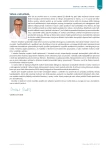Lysosomal acid lipase deficiency: one of the possible causes of dyslipidemia and hepatopathy
Authors:
Eva Tůmová; Michal Vrablík
Published in:
AtheroRev 2019; 4(3): 171-175
Category:
Overview
Rare autosomal recessive hereditary storage disease caused by deletion mutation of the LIPA gene may cause, among other things, development of dyslipidemia and liver dysfunction. This is a lysosomal acid lipase deficiency (LAL-D), the age of the disease manifestation and its progression depends on the type of mutation. If the disease manifestations occur during the first weeks after birth, it tends to have a fulminant course and the affected rarely survive six months of life. In older children and adults the symptoms tend to be milder and the disease manifests itself by any of the following symptoms: dyslipidemia, hepatomegaly, laboratory hepatopathy, the disease gradually progresses to lead to liver fibrosis, cirrhosis and liver failure. Another clinical manifestation is frequently cardiovascular complications which are not exceptional even in pediatric patients. Since these patients are often monitored by gastroenterologists, hepatologists or cardiologists, LAL-D is often underdiagnosed. This paper summarizes the manifestations of the disease and provides practical guidance on how to locate patients and diagnose this rare storage disease, including the design for a diagnostic algorithm with lysosomal acid lipase testing. The review also summarizes the current treatment options for patients with a confirmed diagnosis of LAL-D with the possibility of enzyme replacement therapy using a recombinant enzyme.
Keywords:
combination therapy – hepatomegaly – Wolman disease – cholesteryl ester storage disease – lysosomal acid lipase deficiency
Sources
- Reiner Z, Guardamagna O, Nair D et al. Lysosomal acid lipase deficiency – an underrecognized cause of dyslipidaemia and liver dysfunction. Atherosclerosis 2014; 235(1): 21–30. Dostupné z DOI: < http://dx.doi.org/10.1016/j.atherosclerosis.2014.04.003>.
- Bernstein DL, Hulkova H, Bialer MG et al. Cholesteryl ester storage disease: review of the findings in 135 reported patients with an underdiagnosed disease. J Hepatol 2013; 58(6):1230–1243. Dostupné z DOI: <http://dx.doi.org/10.1016/j.jhep.2013.02.014>.
- Hulkova H, Elleder M. Distinctive histopathological features that support a diagnosis of cholesterol ester storage disease in liver biopsy specimens. Histopathology 2012; 60(7): 1107e13.10.1111/j.1365–2559.2011.04164.x.
- Abramov A, Schorr S, Wolman M. Generalized xanthomatosis with calcified adrenals. AMA J Dis Child 1956; 91(3): 282e6.
- Fredrickson DS. Newly recognized disorders of cholesterol metabolism. Ann Intern Med 1963;58(4):718.10.7326/0003–4819–58–4–718_1
- Aslanidis C, Ries S, Fehringer P et al. Genetic and biochemical evidence that CESD and Wolman disease are distinguished by residual lysosomal acid lipase activity. Genomics 1996;33(1):85e93. 10.1006/geno.1996.0162
- Stein J, Garty BZ, Dror Y, et al. Successful treatment of Wolman disease by unrelated umbilical cord blood transplantation. Eur J Pediatr 2007;166:663e6.
- Grabowski GA, Charnas L, Du H. Lysosomal acid lipase deficiencies: the Wolman disease/cholesteryl ester storage disease spectrum. In: Valle D, Beaudet AL, Vogelstein B, Kinzler KW, Antonarakis SE, Ballabio A, editors. Scriver’s online metabolic and molecular bases of inherited disease. McGraw Hill; [accessed 28.10.13], http://www.ommbid.com/OMMBID/the_online_metabolic_and_molecular_bases_of_inherited_disease/b/abstract/part16/ch142.
- Saito S, Ohno K, Suzuki T, et al. Structural bases of Wolman disease and cholesteryl ester storage disease. Mol Genet Metab 2012;105:244e8.
- Jeon TI, Osborne TF. SREBPs: metabolic integrators in physiology and metabolism. Trends Endocrinol Metab 2012;23:65e72.
- Cummings MH, Watts GF. Increased hepatic secretion of very-low-density lipoprotein apolipoprotein B-100 in cholesteryl ester storage disease. Clin Chem 1995;41:111e4.
- Fouchier SW, Defesche JC. Lysosomal acid lipase A and the hypercholesterolaemic phenotype. Curr Opin Lipidol 2013;24:332e8.
- Wolman M, Sterk VV, Gatt S, et al. Primary familial xanthomatosis with involvement and calcification of the adrenals. Report of two more cases in siblings of a previously described infant. Pediatrics 1961;28:742e57.
- Zhang B, Porto AF. Cholesteryl ester storage disease: protean presentations of lysosomal acid lipase deficiency. J Pediatr Gastroenterol Nutr 2013;56:682e5.
- Guardamagna O, Cagliero P, Abello F. Management of inherited atherogenic dyslipidemias in children. Ther Apher Dial 2013;17:150e61.
- Hamilton J, Jones I, Srivastava R, et al. A new method for the measurement of lysosomal acid lipase in dried blood spots using the inhibitor Lalistat 2. Clin Chim Acta 2012;413:1207e10.
- Quinn AG, Burton B, Deegan P, et al. Sustained elevations in LDL cholesterol and serum transaminases from early childhood are common in lysosomal acid lipase deficiency. Mol Genet Metab 2014;111:S89.
- Abello F, Guardamagna O, Baracco V, et al. The treatment of colesteryl storage disease (CESD) by ezetimibe monotherapy. Atheroscler Suppl 2010;11:28.
- Grabowski GA. Therapy for lysosomal acid lipase deficiency: replacing a missing link. Hepatology 2013;58:850e2.
- Balwani M, Breen C, Enns GM et al. Clinical effect and safety profile of recombinant human lysosomal acid lipase in patiens with cholesteryl ester storage disease. Hepatology 2013;58:950e7.
- Whitley CB. North American Society for Pediatric Gastroenterology, Hepatology and Nutrition (NASPGHAN) Annual Meeting 2013 [Oral Presentation, 11 October 2013].
Labels
Angiology Diabetology Internal medicine Cardiology General practitioner for adultsArticle was published in
Athero Review

2019 Issue 3
Most read in this issue
- Ten ways of using ezetimibe, or a brief guide to its use today
- A statement of the Committee of the Czech Society for Atherosclerosis on the 2019 ESC/EAS Recommendations for the diagnosis and treatment of dyslipidemia
- Specificities of the treatment for vascular system diseases in patients with a chronic renal disease
- Dyslipidemia in patients with chronic kidney disease
